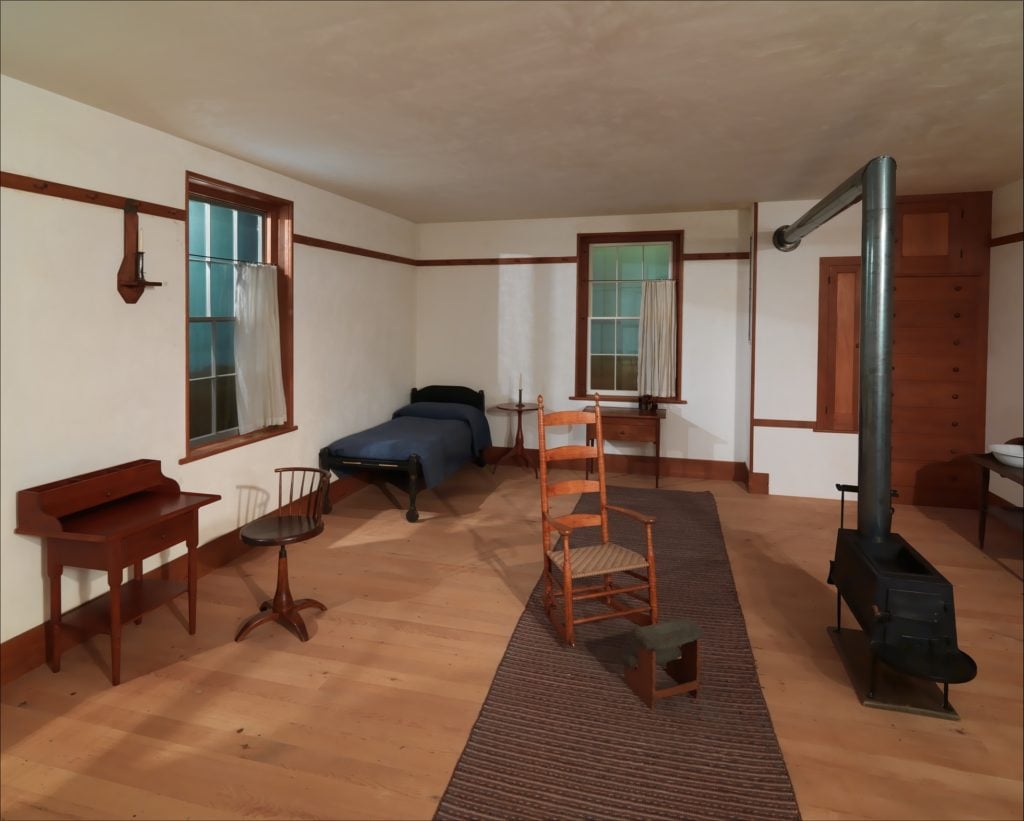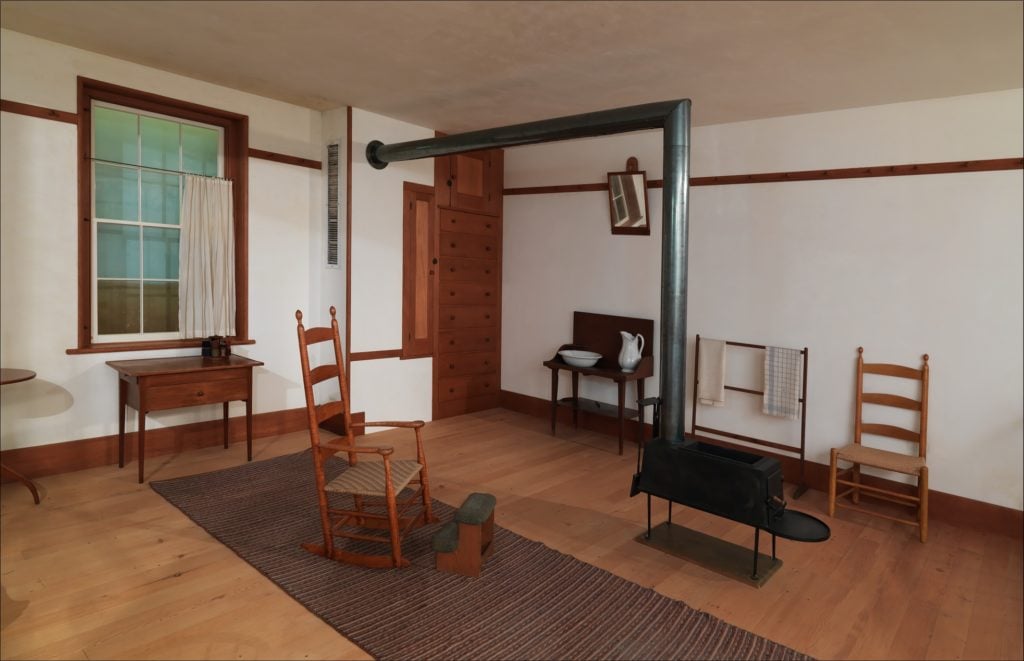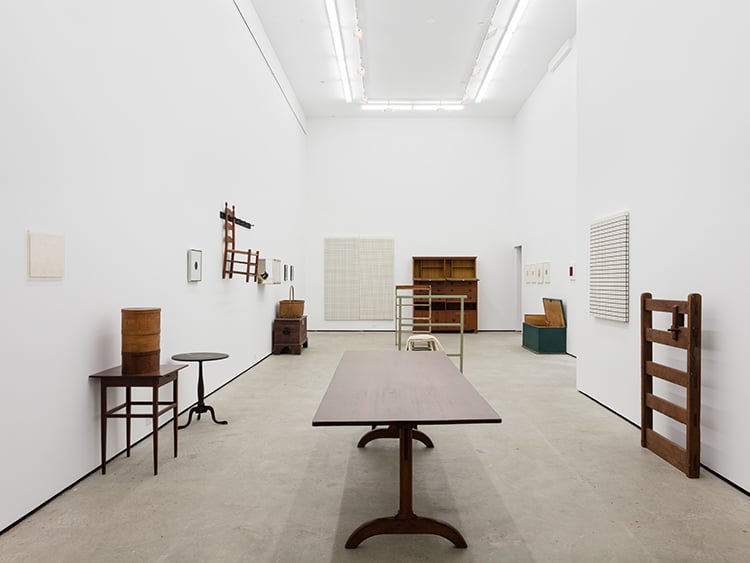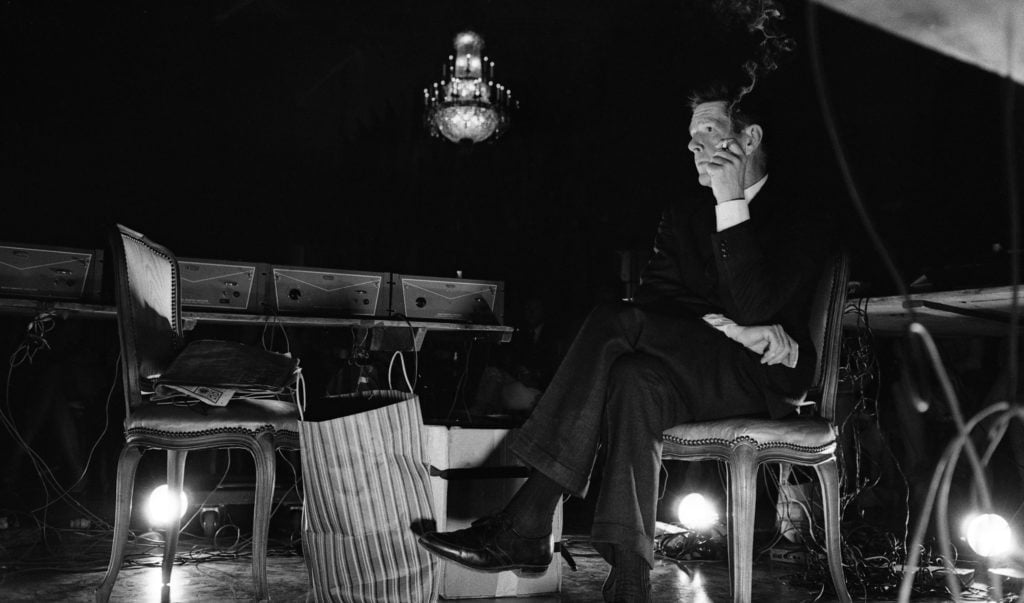Opinion
What Shaker Furniture Can Teach Us About the ‘New Minimalist’ Trend + Two Other Illuminating Pieces of Criticism From Around the Web
Plus, considerations on John Cage's revolt against Musak, and the rise of "Rural Futurism."

Plus, considerations on John Cage's revolt against Musak, and the rise of "Rural Futurism."

Ben Davis

What ideas are percolating out there in the world of art media? This week, here are three essays (well, an essay, a podcast, and an interview) worth thinking about. Enjoy!

The Shaker Retiring Room at the Metropolitan Museum of Art. Image: Public domain.
Lately, a lot of talk has orbited the “New Minimalism,” a vogue captured and amplified by Kyle Chayka’s buzzy new book, The Longing for Less.
An essay from Mousse‘s winter issue by Alessandro Bava comes at the same conversation from a different angle, looking at the history and newly refreshed popularity of Shaker furniture (seen recently, for instance, in “Concerning Superfluities: Shaker Material Culture and Affinities” at Essex Street gallery in New York, which put Shaker objects in conversation with works by Robert Gober, Agnes Martin, and Rosemarie Trockel).
“A new minimalistic material dimension is emerging that defines new habits… yet distinctly recalls much older kinds of minimalism,” Bava heralds. This seems to be indisputably true, as does his explanation of the background against which this new austere sensibility takes its appeal: the “explosion of spiritual practices such as mindfulness (and their ambiguous purposing) that have arisen in response to the extreme demands of cognitive work and the commodification of affect and emotion.”
Shaker furniture’s gorgeously spare forms have long stood as icons of homegrown American functionalism: no-nonsense usefulness as beauty. The newness of the New Minimal sensibility, in Bava’s telling, is that instead of detaching it from its rootedness in religious experience to turn its objects into prototypes of streamlined mass-produced “good design,” the emphasis increasingly falls specifically on the spiritual, ethereal dimension of Shaker aesthetics: these are not just things optimized for efficiency, but pieces that fit into a spiritually rich way of life, where each object is charged with symbolic meaning as part of a holistic, anti-materialistic way of living.
Bava emphasizes the proto-political aspects of Shaker aesthetics. The Shakers were, after all, proto-socialist, holding property in common. The Shaker experiment was one of the utopian, religious, communitarian, and millennarian reactions that accompanied the disruptions of the early Industrial era. So there’s a direct link between contemporary New Minimalist ways of living as a rejection of ultra-consumerist, ecologically wasteful lifestyles, and pre-20th century religious forbearers.

Installation view, “Concerning Superfluities: Shaker Material Culture and Affinities,” ESSEX STREET, New York, 2019
It’s worth adding that 19th-century “scientific socialism”—the political movement associated with Marx and Engels, the Communist Manifesto, and the workers’ movement—defined itself as both inspired by and critical of “utopian socialist” communities. Marx and Engels thought such alternative lifestyles had inspiring insights and captured powerful currents of alienation; but they also thought the utopians were deflecting that alienation into small-scale experiments that avoided confrontation with the more powerful institutions of society, the ones that actually had the resources to make large numbers of lives better. Small-scale solutions, they argued, were doomed to remain fragile and dependent.
Which is exactly the problem that plagued the Shakers (that and the fact that they were against procreation). The reason the world even knows about Shaker chairs, chests, ladders, and so on in the first place is because the utopian project was never able to achieve autonomy from the outside world. “[T]heir economy could only properly function thanks to the production of surplus goods to be sold to the outside world, and what made these goods particularly attractive and expensive was their impeccable manufacture, supported by a labor culture that aimed for perfection as ‘making the way of God your own,’” Bava writes. “Thus Shaker communism was possible only as an island immersed in a market economy perceived as a necessary outside evil.”
Bava views Shaker Minimalism as a resource to “imagine alternative models” for new, less disposable relations to material culture. But he also ends up concluding, somewhat cryptically, that “of course this cannot be achieved simply by design, because also in politics every force evolves a form.” Basically, you can’t just design your way out of alienation, because alienation is not solely a matter of bad design. It’s bound up with political economy: who has power and how money is earned or allocated.

Shaker Trestle Table (ca. 1840). Likely Watervliet, New York.
A rare example of a classic Shaker trestle table having a two board top above two beveled tapering cleats supported by carved standards mortised into an arched footed base. Image courtesy Essex Street Gallery.
I’d add that, ultimately, it isn’t clear to me whether the aesthetic and “ethical” sides of spiritual Minimalism can fully be reconciled with the political reading of them.
If you take, for example, contemporary “mindfulness” practices as an avatar of New Minimalist thinking, it is clearly a way for alienated urbanites to register the strains of a very fragmented and commodified world and to reconnect with a sense of place, presence, and community.
At the same time, mindfulness tends to become both a boutique luxury commodity and a cheapo replacement for mental health care, and can turn devotees away from bigger thinking about how to change systems that produce so much mental strain, and towards individual self-help, mental hacks, and spiritual hoodoo. (An interesting debate raged on the openDemocracy website all last year about how mindfulness practices might be disconnected from “magical thinking,” and attached more fully to political perspectives.)
In any case, I think it clear that this New Minimalist vogue is definitely interesting to explore, and also that you’ll be seeing more and more emphasis on spiritual minimalism in contemporary art. It’s just worth untangling what in it is a symptom of a problem, and what is an actual answer to a problem. When all you have is a hammer, every problem looks like a nail; when you’re an art critic, it’s possible that every problem looks like a smartly designed Shaker chair.

Composer John Cage during a concert of his at the opening of the National Arts Foundation, Washington, DC, 1966. Photo by Rowland Scherman/Getty Images.
This Dallas Taylor-hosted podcast focuses on sound, but this episode’s exploration of silence—and specifically 4’33”, John Cage’s silent masterwork—is really worth the listen. I’ve always understood 4’33” as Cage’s attempt to tie avant-garde provocation to his explorations of randomness and the I-Ching, but Taylor makes what I consider to be a more contemporary and interesting case for it.
You need to understand 4’33”, the argument goes, against the history of… Muzak. The increasing presence of pre-recorded mood music in public spaces outraged musicians in the 1950s, and led to lots of anxiety about sonic pollution and the loss of an audience’s ability to actually pay attention, as music was bleached of meaning and treated as wallpaper. A delightful detail: in 1952, the same year 4’33” premiered, “a college student in the Midwest… started selling silent records for jukeboxes. So if you didn’t want to listen to the jukebox for a moment, you could put in your nickel.” 4’33”‘s intensified focus on just listening to your sonic environment as an artistic act in itself emerges from that sense of revolt against too much music, too much stimulus.
To me, that’s a convincing argument that links up Cage’s interests in Zen practice to—projecting forward—the contemporary New Minimalist mindfulness foment. (Chayka’s The Longing for Less, incidentally, also digs into 4’33”.)
Régine Debatty’s We Make Money Not Art blog leads me to the “Rural Futurism” manifesto, launched by Beatrice Ferrara and Leandro Pisano last year (and emerging from Manifesta 12 from 2018).
With Rem Koolhaas’s “Countryside, The Future” show about to debut at the Guggenheim (exploring “radical changes in the rural, remote, and wild territories”), this focus on rural avant-gardism seems like another vogue worth marking.
Basically, Ferrara and Pisano are making the case that we should treat rural areas not as raw suppliers of goods for metropolitan life, nor as areas that have been left behind, but as places participating fully in what it means to live in the present, and full of knowledge about how different forms of life cross one another.
The interesting thing to me is that, thus far, as an art style “Rural Futurism” seems mainly to involve audio art as a practice of “deep listening.” (You can hear examples here). Classic early 20th-century Italian Futurist art was all about celebrating the collision of images and people in the city, advocating for the beauty of technology, taking traditional forms of art-making and giving them a technological makeover. It represented the technophilia of an underdeveloped society.
“Rural Futurism,” also rooted in Italy, so far has focused on oral histories, field recordings, and audio collages of landscapes meant to focus attention on the different aspects of the actually existing rural world. In essence, it is a reflex of an overdeveloped society that is realizing that it may have to listen to what it thought was its past to find its actual future.